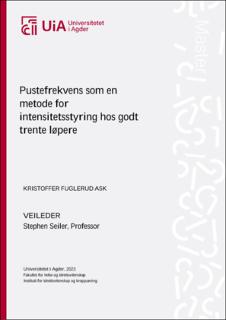| dc.description.abstract | ABSTRACT:
BACKGROUND: Respiratory rate (RR) is the body's most visible parameter of internal physiological load. Due to challenges in measuring it with other specific measurement methods, RR has mainly been used as a subjective measure of intensity outside the lab. Increased focus on training monitoring has resulted in new wearables that open up the possibility of using RR as a measure of internal physiological load. This study aimed to evaluate (1) the utility of RR as an internal physiological measure for intensity control, (2) the validity and functionality of the newly developed Tyme WearTM shirt.
METHOD: Seventeen (11 men, 6 women) well-trained runners (30 ± 6 years, 69 ± 12.7 kg, 175 ± 10 cm, maximum oxygen uptake 61 ± 4 ml.kg-1.min-1) participated in the study. After preliminary testing, the runners completed a long run, threshold run, long interval run, and short interval run in a randomized order. Relevant physiological and perceptual receptors were repeatedly measured during each training session.
RESULTS: Vyntus and Tyme WearTM shirt showed strong correlation in measuring maximal respiratory rate (RRmax) (r = 0.986, p < 0.001). RRmax measured by the shirt during runs to exhaustion without a mask showed a significant difference (y = 0.9687x + 10.607, p < 0.05, r = 0.45) compared to the same run with a mask. Percent change in respiratory rate reserve (%RRR) was greater compared to %HRR during LIT (p < 0.001, d = 0.8), TIT (p < 0.001, d = 0.9), HIT (p < 0.001, d = 0.8), and SIT (p < 0.05, d = 0.6).
CONCLUSION: RR can be a useful measure for intensity control, and the vest provides valid measurements of RR during training in controlled environments. The benefits of monitoring RR during training include more precise intensity control and better quantification of changes in mobilization during training sessions.
KEYWORDS: Endurance, running, respiratory rate, training load, monitoring. | |
